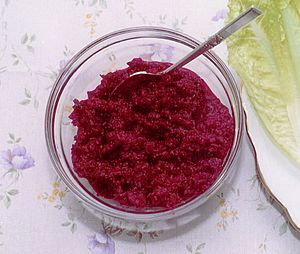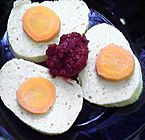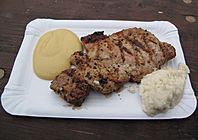Chrain facts for kids
Chrain is a super spicy paste made from a plant called horseradish. It's often used like a sauce or dip with different foods, especially meat and fish. You'll find it a lot in countries in Eastern and Central Europe, like Poland, Russia, and Germany, and also in Ashkenazi Jewish cooking. The word "chrain" comes from a language called Yiddish, and it simply means "horseradish."
What is Chrain?
Chrain is a popular condiment, which means it's something you add to food to give it extra flavor. It's made by grating the root of the horseradish plant. This plant has a very strong, pungent taste that can make your nose tingle! People in many countries, including Belarus, Czech Republic, Germany, Poland, Romania, Russia, and Ukraine, enjoy chrain with their meals. It's also a big part of Ashkenazi Jewish cuisine.
Different Kinds of Chrain
There are two main types of chrain you'll often see, especially in Slavic and Jewish cooking:
- White chrain: This kind is made from grated horseradish mixed with vinegar. Sometimes, a little sugar and salt are added to balance the flavors.
- Red chrain: This version gets its color from beetroot (also known as beets). Beetroot is added to the horseradish, giving it a vibrant red color and a slightly different taste.
One cool thing about these types of chrain is that they are "pareve". This means they don't contain any dairy products. Because of this, they fit with Jewish dietary laws and can be eaten with both meat and dairy meals. Some other types of horseradish sauces in Central Europe might include cream or sour cream. You can also find chrain with other fruits like apples, lingonberry, cranberry, or oranges.
Where is Chrain Used?
People have been using chrain in Jewish communities in Eastern and Central Europe for a very long time. We know it was used as far back as the 12th century! Today, chrain is most famous for being served with gefilte fish, which is a traditional Jewish dish. Many people think it's an essential part of eating gefilte fish.
In Eastern and Central European cooking, chrain is a common condiment for many different fish dishes. It's also served with various meat and fish zakuski (which are like appetizers or small dishes). For example, it's often eaten with kholodets (a savory jelly dish) and beef tongue.
-
Meat with mustard (left) and white chrain (right)
See also
 In Spanish: Chrain para niños
In Spanish: Chrain para niños





